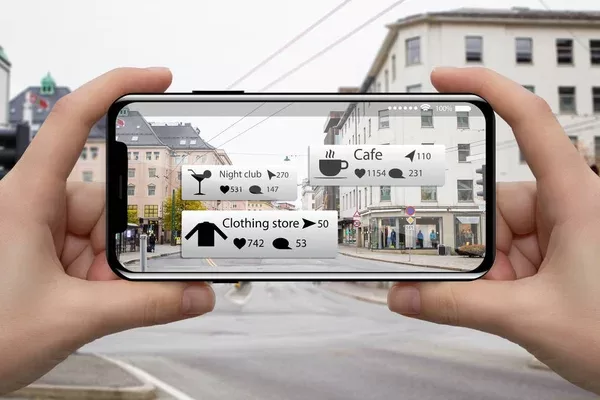What is augmented reality?
Definition and fundamental principles
Augmented reality, often abbreviated as AR, is a technology that enhances our perception of the real world by adding virtual information. Unlike virtual reality, which immerses us in a completely artificial environment, augmented reality maintains our connection to the physical world while enriching it with digital elements.
This overlay occurs in real time and contextually. Virtual information adapts to our position, orientation, and immediate surroundings. When you point your smartphone at a monument to get historical information or virtually try on glasses before buying them, you’re using augmented reality.
The different types of augmented reality
Augmented reality is divided into several categories depending on the detection and display method used:
- Marker-based augmented reality uses specific reference images, called markers, to trigger the display of virtual elements. These markers can be QR codes, logos, or specially designed images. This approach offers high accuracy but requires the physical presence of the marker.
- Markerless augmented reality, more sophisticated, relies on natural environment recognition. It uses computer vision algorithms to identify surfaces, objects, or geometric shapes in the real environment. This technology allows for a more fluid and natural experience.
- Location-based augmented reality uses GPS data and motion sensors to display information related to a specific geographic location. It is particularly used in navigation and tourism applications.
How does augmented reality work?
The underlying technologies
Augmented reality relies on a complex combination of technologies working together to create an immersive experience. The first step is image capture, performed by high-resolution cameras capable of filming the environment in real time.
Image processing and computer vision then analyze this visual data. Sophisticated algorithms identify surfaces, recognize objects, and calculate distances. These technologies allow the system to understand the geometry of the environment and determine where to place virtual elements. Motion sensors, including accelerometers, gyroscopes, and magnetometers, provide crucial information about the device’s orientation and movement. This data helps maintain the consistency of virtual elements even when the user moves.
The real-time rendering process
Creating a compelling augmented reality experience requires extremely accurate real-time rendering. The system must calculate the exact position and orientation of virtual objects dozens of times per second to maintain the illusion of their presence in the real world.
This technical feat requires considerable computing power. Modern processors, particularly chips dedicated to artificial intelligence, play a crucial role in this task. They allow for the necessary complex calculations to be performed while maintaining acceptable display fluidity. Camera calibration and sensor calibration are also fundamental technical aspects. Each device has slightly different characteristics that must be taken into account to ensure the accurate placement of virtual objects.
Augmented reality devices and platforms
Smartphones and tablets
Smartphones are currently the most accessible platform for augmented reality. With their built-in cameras, motion sensors, and increasing computing power, they offer a natural gateway to this technology. Apple with ARKit and Google with ARCore have developed specific frameworks that facilitate the development of augmented reality applications on mobile devices.
This democratization through smartphones has led to the emergence of consumer apps like Pokémon Go, which has introduced millions of users to the basic concepts of augmented reality. E-commerce apps are also using this technology to allow customers to virtually try on products before purchasing.
Augmented reality glasses and headsets
Augmented reality glasses represent the future of this technology by offering a more natural, hands-free experience. Microsoft HoloLens, Magic Leap, and smart glasses from various startups are exploring different approaches to integrating the display of virtual information into our natural field of vision. The most ambitious project at the moment is the Meta Orion , which will not arrive on the market for several years. The Apple Vision Pro , while primarily focused on virtual reality, incorporates augmented reality features that foreshadow the evolution of this market. Its approach to “spatial computing” skillfully blends the real and the virtual.
These devices face considerable technical challenges: miniaturization of components, battery life, acceptable weight for prolonged wear, and sufficient display quality. Despite these constraints, they open up fascinating prospects for professional and, ultimately, consumer use.
Specialized industrial devices
The industry is developing augmented reality solutions specifically designed for demanding professional environments. These rugged devices withstand harsh conditions and incorporate features specific to industrial needs.
Augmented reality headsets for industrial maintenance allow technicians to access contextual technical information without taking their eyes off their work area. These solutions improve efficiency and reduce the risk of error in complex environments.
Current applications of augmented reality
Trade and retail
The retail industry has quickly adopted augmented reality to enhance the shopping experience. Virtual try-on apps allow consumers to test clothing, accessories, or cosmetics without visiting a store. Sephora, L’Oréal, and many other fashion brands now offer these features.
Furniture and decoration are particularly benefiting from this technology. IKEA Place allows customers to visualize furniture in their own home before purchasing, significantly reducing returns and improving customer satisfaction. This approach is transforming the way we think about purchasing large or difficult-to-evaluate products remotely. Physical stores are also incorporating augmented reality to enrich the point-of-sale experience. From smart mirrors to contextual product information, this technology is creating bridges between the physical and digital worlds.
Education and training
Education has found augmented reality to be a powerful pedagogical tool for making learning more interactive and memorable. Enhanced textbooks allow students to visualize complex concepts in three dimensions, from chemical molecules to historical monuments.
Professional training makes extensive use of this technology to simulate dangerous or costly situations. Pilots, surgeons, and technicians can train in safe virtual environments while maintaining contact with real equipment. Museums and cultural sites use augmented reality to enhance their tours. Virtual historical reenactments allow visitors to see monuments in their original state or access enhanced contextual information.
Health and medicine
The medical field is gradually adopting augmented reality to improve the accuracy of procedures and practitioner training. Surgeons can superimpose medical images directly onto the patient, guiding their actions with unparalleled precision.
Rehabilitation also benefits from this technology. Gamified augmented reality exercises motivate patients and enable accurate monitoring of their progress. This approach improves treatment adherence and rehabilitation outcomes. Telemedicine incorporates augmented reality elements to support remote consultations. Physicians can guide patients in using measuring instruments or observing symptoms.
Industry and maintenance
Industry 4.0 relies heavily on augmented reality to optimize production and maintenance processes. Technicians equipped with AR glasses instantly access technical diagrams, maintenance procedures, and intervention logs.
This technology reduces response times and improves repair quality. Boeing uses augmented reality to guide aircraft assembly, reducing errors and speeding up production. The training of skilled workers also benefits from these tools. New employees can learn on real equipment while benefiting from detailed virtual guidance.
Entertainment and gaming
The entertainment industry is actively exploring the possibilities offered by augmented reality. Beyond Pokémon Go, many video games are leveraging this technology to create immersive experiences that blend the real and virtual worlds.
Theme parks are beginning to integrate augmented reality into their attractions. This technology allows for personalized experiences and content updates without costly physical modifications. Film and television are also experimenting with augmented reality to create interactive narrative experiences where the viewer becomes an actor in the story.
Technical challenges and current limitations
Material constraints
Augmented reality faces significant technical challenges that still limit its widespread adoption. The computing power required for high-quality real-time rendering remains significant, impacting the battery life of mobile devices and the miniaturization of dedicated devices.
Display is another major challenge. Current screens struggle to accurately reproduce natural lighting conditions, sometimes creating disturbing visual lags. The latency between user movements and display updates can also cause discomfort. Tracking accuracy—that is, tracking the user’s position and orientation—remains imperfect under certain conditions. Low-light environments, reflective surfaces, or rapid movements can disrupt recognition systems.
Software limitations
Computer vision algorithms, although constantly improving, still face challenges in certain situations. Object recognition in complex or changing environments remains a challenge, particularly for markerless augmented reality systems.
Artificial intelligence is playing a growing role in improving this performance, but current models still require significant computational resources. Optimizing these algorithms for resource-constrained mobile devices is a major technical challenge.
User acceptance and ergonomics
The adoption of augmented reality depends largely on user acceptance. Current interfaces often require a learning curve, which can put some users off. Designing intuitive and natural experiences remains a challenge for designers.
Ergonomics are particularly important for wearable devices. Weight, balance, and comfort during prolonged use directly influence the adoption of these technologies. Augmented reality glasses must achieve a level of comfort equivalent to traditional glasses to appeal to the general public.
The Future of Augmented Reality
Expected technological developments
The coming years promise significant advances in the field of augmented reality. The miniaturization of components will enable the development of lighter and more discreet glasses. Advances in adaptive optics will improve display quality and reduce eye strain.
Artificial intelligence will continue to play a central role in improving performance. Object recognition and scene understanding algorithms will become more accurate and less resource-intensive. Machine learning will enable systems to automatically adapt to each user’s preferences and habits.
5G connectivity and future generations of mobile networks will open up new possibilities by shifting some of the computing to the cloud. This approach will make devices lighter while delivering richer and more complex experiences.
Convergence with other technologies
Augmented reality will increasingly converge with other emerging technologies. The Internet of Things will provide enriched contextual data to create more personalized and relevant experiences. Connected objects will be able to communicate directly with AR systems to display status or control information.
Generative artificial intelligence will enable the automatic creation of augmented reality content tailored to specific contexts and needs. This capability will expand creative possibilities and reduce development costs.
Blockchain and cryptocurrency technologies could also integrate with augmented reality to create virtual economies and digital ownership experiences in physical space.
Societal and economic impact
The democratization of augmented reality will likely transform many aspects of our society. Jobs in training, retail, maintenance, and entertainment will evolve to incorporate these new possibilities. New jobs will emerge around content creation and AR application development.
Education could be revolutionized by immersive teaching methods that will make learning more effective and engaging. Telemedicine and remote technical assistance will benefit from these tools to improve access to specialized services.
Privacy and security issues will become increasingly important as these technologies collect and process more personal data. The regulatory framework will need to evolve to regulate these uses while preserving innovation.
Augmented Reality vs. Virtual Reality: The Key Differences
Distinct technical approaches
Augmented reality and virtual reality pursue different goals, which are reflected in their technical approaches. Virtual reality aims for total immersion in an artificial environment, requiring occlusive headsets that cut the user off from the real world. This approach allows for complete control of the experience but limits mobility and interaction with the physical environment.
Augmented reality prioritizes enriching the real world rather than replacing it. This philosophy imposes different technical constraints: devices must be transparent or semi-transparent, allow mobility, and adapt to the varying lighting conditions of the real world.
Complementary use cases of augmented reality
These technical differences naturally lead to distinct but complementary use cases. Virtual reality excels in applications requiring total immersion: video games, complex training simulations, virtual tours of inaccessible environments. It allows for the creation of experiences impossible in the real world.
Augmented reality shines in situations where the user must maintain a connection with their physical environment: industrial maintenance, navigation, commerce, technical support. It improves the efficiency of real-life tasks rather than creating alternative experiences.
Towards technological convergence
Technological developments are moving toward a convergence of these approaches in what is known as mixed reality. Future devices will likely be able to switch between augmented and virtual modes as needed, offering the best of both worlds.
This technical convergence is accompanied by a convergence of software ecosystems. Development platforms are beginning to unify creation tools for augmented and virtual reality, facilitating the development of hybrid applications.
Augmented reality: economic challenges and business models
Current market and projections
The augmented reality market is experiencing sustained growth, driven by adoption in industrial sectors and the emergence of consumer applications. Analysts predict significant expansion in the coming years, particularly in B2B segments where return on investment is more easily measurable.
This growth is driven by several factors: lower development costs, improved technical performance, and the emergence of high-value use cases. Companies are beginning to view augmented reality not as a technological curiosity, but as a tool for improving productivity.
Emerging economic models
Several business models are emerging around augmented reality. Traditional paid applications are alongside freemium models where advanced features are paid for. Subscriptions are gaining popularity for professional solutions, offering continuous access to updates and support.
Augmented reality advertising opens up new marketing opportunities. Brands can create contextual, interactive experiences that engage consumers in new ways. This advertising potential attracts investment and funds the development of free apps.
Integrated e-commerce represents another promising model. Apps that allow virtual product testing facilitate the purchase process and can generate revenue through commissions or partnerships with brands.
Challenges for businesses
Business adoption of augmented reality faces several obstacles. Initial development and deployment costs remain high, particularly for custom solutions. Training teams and adapting business processes require investments of time and resources.
Measuring return on investment remains complex, particularly for customer experience or training-oriented applications. Companies must develop new performance indicators adapted to these immersive technologies.
Ethical and societal considerations of augmented reality
Privacy and data protection
Augmented reality raises significant privacy concerns. These technologies collect particularly sensitive visual and location data, which can reveal intimate information about users and their surroundings. Captured images may inadvertently include third parties, raising questions about consent.
Storing and processing this data requires enhanced security protocols. Companies developing AR solutions must integrate privacy by design, in accordance with regulations such as the GDPR in Europe.
Transparency about data usage is becoming crucial to maintaining user trust. Privacy policies must be clear and accessible, explaining what data is collected, how it is used, and with whom it can be shared.
Impact on social interactions
The democratization of augmented reality could profoundly change our social interactions. The omnipresence of virtual information risks creating a form of “information pollution” that could disrupt natural human relationships.
Paradoxically, this technology can also enrich interactions by providing shared contexts and common experiences. Collaborative AR applications allow multiple users to share the same augmented virtual space, creating new forms of socialization.
Accessibility and digital inclusion
Augmented reality has significant potential to improve accessibility. It can provide audio information for people with visual impairments, visual translations for people who are deaf, or navigation guides for people with limited mobility.
However, the cost of these devices and the complexity of their use threaten to create a new digital divide. Designers must ensure they develop inclusive solutions that ensure no one is left out of this technological revolution.
Augmented Reality: Frequently Asked Questions
What exactly is augmented reality?
Augmented reality is a technology that superimposes virtual elements (images, text, 3D objects) onto our real environment, visible through a screen or specialized glasses. Unlike virtual reality, it does not replace the real world but enriches it with contextual digital information.
Which devices can use augmented reality?
Augmented reality can be used on smartphones, tablets, specialized glasses (like HoloLens), mixed reality headsets, or dedicated industrial devices. Smartphones remain the most accessible platform thanks to Apple’s ARKit and Google’s ARCore technologies.
What are the main applications of augmented reality today?
Application areas include retail (virtual fitting), education (interactive learning), medicine (surgical assistance), industry (guided maintenance), entertainment (games like Pokémon Go), and navigation (context-aware information).
What is the difference between augmented reality and virtual reality?
Augmented reality enhances the real world with virtual elements while maintaining your connection to the physical environment. Virtual reality immerses you completely in an artificial world, completely cutting off contact with reality.
What are the main challenges of augmented reality?
Challenges include technical limitations (computing power, battery life), tracking accuracy under certain conditions, the ergonomics of wearable devices, and privacy issues related to visual data collection.
How does object recognition work in augmented reality?
Recognition uses computer vision algorithms that analyze images captured by the camera. The system identifies shapes, surfaces, and objects, then calculates their position in space to precisely place the corresponding virtual elements.
What is the future of augmented reality?
The future promises lighter and more discreet glasses, better integration with AI, the deployment of 5G for cloud experiences, and convergence with other technologies like IoT. This democratization will gradually affect all sectors of activity.
Is augmented reality safe for health?
Current research does not indicate any major risks for moderate use. However, prolonged use may cause eye strain or headaches. It is recommended to take regular breaks and properly adjust the display settings of the devices.






